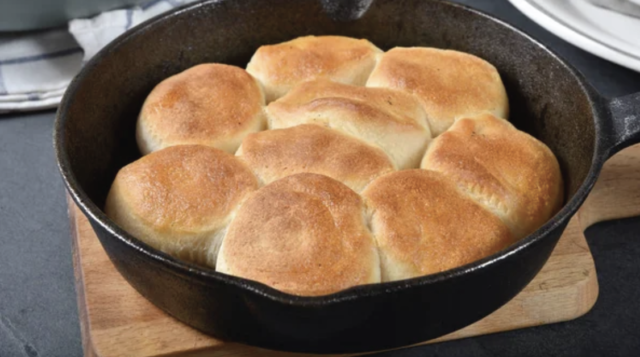by Kelly Reeves
“Cat head biscuits have saved more lives than the Red Cross.”
-Alma McKay
My Nanny was born in the year 1912. She was the oldest of five children who lost their mother in 1924. Although cooking was something she helped her mother with as a youngster, she hadn’t planned to take over the responsibility of cooking for the entire family at the age of twelve.
Nevertheless, she had no choice but to jump in with both feet. In 1924, she didn’t open a can of “Whop Biscuits” and slide them into an electric oven. She built a fire in the cookstove and let it heat. Then she mixed the flour, baking powder, lard or shortening, salt, and whole milk, worked it into a dough, rolled it out, cut the biscuits, put them into greased pans, and baked them. She also had to come up with something to go with the biscuits, be it eggs, ham, gravy, jelly, or whatever she could find that would fill a belly.
Nanny made at least two pans of biscuits daily for the next fifteen or so years until she got her siblings grown and she married. She continued baking biscuits for her husband and three children, and too many grand and great-grandchildren to count. She often said that biscuits, purple hull peas, and turnip greens were all that saved their lives during the early years and the great depression. Just for fun let’s put the pencil to it. If each pan holds eight biscuits, that is at least sixteen biscuits each day. 365 X 16 equals 5,840 biscuits each year for the next 65 years, which equals 379,600 biscuits. She was responsible for baking around 400,000 biscuits during her lifetime. If anyone knew how to bake a biscuit, it was Nanny.
Now, there are many kinds of biscuits. Southern cat head biscuits are different from biscuits made north of the Mason-Dixon line and very different from European biscuits. These original southern biscuits are hearty and dense, not crumbly, or flaky. That’s where the lard or shortening comes into play. The lard can be replaced with butter and the result is a tasty biscuit, but too flaky or crumbly to make a good soppin’ biscuit. Butter biscuits will suffice for smearing honey, jelly, or apple butter on, but soppin’ up your plate is out of the question. Only lard or shortening will make a proper sopper.
“What is this sopping?” some of you may ask. The answer is quite simple: after your meal is complete, you either break off a piece of a biscuit, or use a piece that you saved specifically for sopping, and drag it across your plate, soaking up any leftover juices from your meal. Pea juice, egg yolk, gravy, creamed potatoes, or whatever residue may be left on the plate is soaked up in the piece of biscuit and then popped into the sopper’s mouth. If necessary, the sopper can repeat the process until the plate is cleaned. Oftentimes, sopping was saved for dessert or just a special treat. Nanny would use a small plate or saucer and pour a small amount of molasses or syrup (pronounced “serp”) in the middle. Then she’d slice off a couple of pats of softened stick butter and drop them in the middle of the syrup, then mash and mix it all together with a fork. This treat was served with a warm biscuit to sop it up. “Serp ‘n butter” was also a perfect way to utilize leftover biscuits so as not to waste one.
Sopping your plate is not necessarily a Southern secret, but it seems to be much more customary and accepted in the South. Not many years ago, it was common to sop your plate after finishing the meal. Nowadays some uppity folks frown on soppin’ and consider it to be taboo. Emily Post, who literally wrote the book on etiquette, was most likely not a sopper. Then again, I don’t associate with any graduates of the Emily Post Institute. If you drop by any local southern cafe for breakfast, you’ll certainly find some of the top soppers in the area. Not only is sopping acceptable but it is also appreciated by the cafe’s dishwasher. A properly sopped plate requires no soaking, very little scrubbing, and there’s not enough left for the dog to bother licking.
I don’t expect anyone in the busy world we live in to swear off whop biscuits and revert back to mixing, rolling, cutting, and baking them as Nanny did, but I am suggesting you purchase canned biscuits suitable for sopping and give it a try. There is a short learning curve while perfecting your technique, but just a little practice will make you a top sopper in no time.












